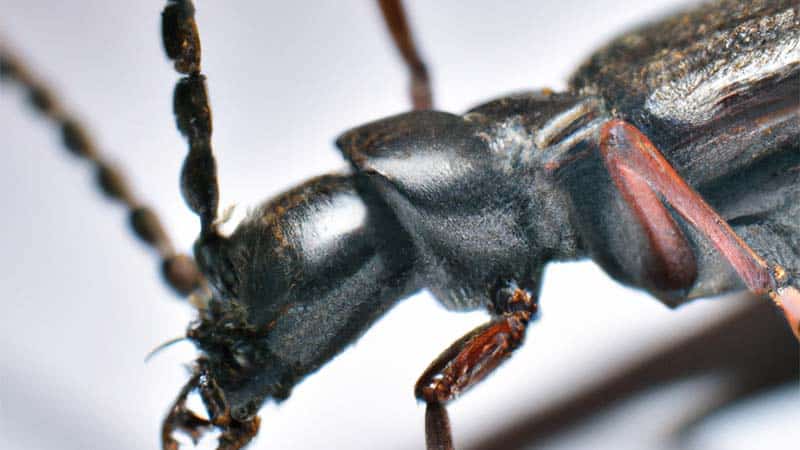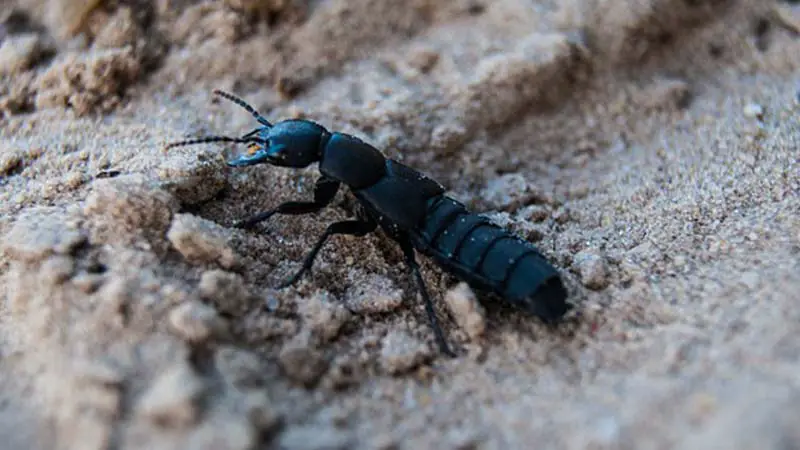Rove beetles can quickly turn a cozy home into an uncomfortable and frustrating place. These small, dark-colored pests have a knack for infiltrating houses and causing havoc with their presence. From their scavenging tendencies to their potential health risks, rove beetles are a nuisance that should be addressed promptly. In this comprehensive guide, we will explore effective strategies to help you get rid of rove beetles and restore peace in your home. Whether you’re dealing with an existing infestation or want to take preventive measures, we will equip you with the knowledge and tools necessary to tackle the problem head-on. So, let’s dive in and discover how to reclaim your living space from these unwelcome intruders.

Understanding Rove Beetles
Rove beetles belong to the Staphylinidae family and are characterized by their elongated bodies, short wing covers, and prominent mandibles. Typically ranging from 1/8 to 3/8 inch in size, these beetles can vary in color from black and brown to metallic shades. They are highly adaptable insects that can thrive in various environments, including gardens, compost piles, and even inside homes.
Rove beetles are known for their scavenging behavior, feeding on decaying organic matter, insects, and plant materials. While they play a crucial role in natural ecosystems by aiding in decomposition, their presence within a residential setting can be unsettling. Rove beetles are attracted to moisture, making kitchens, bathrooms, and damp basements their preferred habitats.
Despite their beneficial ecological role, rove beetles can become a nuisance when their populations grow out of control. In rare cases, some species of rove beetles can deliver painful bites, although they generally avoid direct contact with humans. However, their presence in large numbers can cause distress, particularly for those with insect phobias or sensitivities. By understanding the behavior and preferences of rove beetles, you can gain valuable insights into how to effectively address and prevent infestations. In the following sections, we will delve into practical methods and strategies to eliminate rove beetles from your home and ensure a pest-free environment.

Identifying Rove Beetle Infestations
Recognizing the signs of a rove beetle infestation is essential for taking appropriate action. Here are some key indicators to help you identify if your home is harboring these pests:
- Sightings: Rove beetles are typically active at night and are attracted to light sources. If you notice an abundance of beetles, especially near windows, light fixtures, or outdoor entry points, it may indicate a potential infestation.
- Foul Odor: Rove beetles release a pungent odor when disturbed or crushed. If you detect a strong, unpleasant smell resembling rotting food or a musty scent, it could be a sign of a significant rove beetle presence.
- Larvae and Eggs: Rove beetle larvae are elongated and resemble small, white worms with dark heads. Look for them in areas with decaying organic matter, such as compost bins or damp soil. Additionally, keep an eye out for tiny rove beetle eggs, which may be hidden in crevices or on plant material.
- Damage to Plants: Some species of rove beetles are known to feed on plants, causing damage to leaves, flowers, or fruits. If you notice unexplained plant damage, inspect the foliage for signs of rove beetle feeding or larvae.
- Skin Irritation: While rare, rove beetles can occasionally bite humans if they feel threatened or trapped. Bites usually result in localized redness, swelling, and irritation resembling a small welt. If you experience unexplained skin irritation, it’s advisable to seek medical attention to rule out other potential causes.
If you suspect a rove beetle infestation, it’s crucial to conduct a thorough inspection to confirm their presence. Inspect areas where rove beetles are commonly found, such as kitchens, bathrooms, basements, and areas with organic debris. Use a flashlight to check dark corners, cracks, and crevices where they may be hiding.
By promptly identifying a rove beetle infestation, you can take appropriate measures to eliminate them effectively. In the next section, we will explore various preventive methods to help you avoid future infestations and create an inhospitable environment for rove beetles.
Prevention Methods
Preventing rove beetle infestations is key to maintaining a pest-free home environment. By implementing the following preventive measures, you can significantly reduce the likelihood of rove beetles taking up residence in your living space:
- Seal Entry Points: Thoroughly inspect your home for any gaps, cracks, or openings that may serve as entry points for rove beetles. Seal these openings with caulk or weatherstripping to prevent their easy access.
- Improve Sanitation Practices: Rove beetles are attracted to decaying organic matter, so it’s essential to maintain cleanliness both inside and outside your home. Promptly dispose of food scraps, keep garbage cans tightly sealed, and regularly clean up fallen leaves and plant debris in your yard.
- Minimize Moisture: Moisture-rich environments are ideal breeding grounds for rove beetles. Repair any leaks in pipes, faucets, or roofs, and ensure proper ventilation in areas prone to dampness, such as basements, bathrooms, and crawl spaces.
- Remove Clutter: Clear clutter from your living spaces, as rove beetles can find hiding places in stacks of papers, unused boxes, and piles of clothing. Maintain a tidy and organized home to minimize potential rove beetle habitats.
- Outdoor Maintenance: Trim vegetation away from the exterior of your home, ensuring a clear gap between plants and the foundation. This prevents rove beetles from easily accessing the structure. Regularly inspect and clean gutters to avoid moisture accumulation.
- Install Window Screens: Properly fitted window screens serve as a barrier against rove beetles and other insects. Check existing screens for tears or holes, and repair or replace them as necessary.
- Lighting Considerations: Rove beetles are attracted to bright lights, which can lead them indoors. Consider using yellow or sodium vapor lights for outdoor lighting, as they are less attractive to these pests.
By incorporating these preventive measures into your routine, you can create an environment that is less conducive to rove beetle infestations. However, if you’re already dealing with a rove beetle problem, the next section will provide you with effective natural remedies for their elimination.
Natural Remedies for Rove Beetles
When dealing with rove beetles, natural remedies can be effective in eliminating them without relying on harsh chemicals. Consider the following eco-friendly approaches to address a rove beetle infestation:
- Essential Oils: Rove beetles are repelled by certain essential oils. Use a few drops of essential oil, such as eucalyptus, peppermint, or tea tree oil and adding with water spray it around potential entry points, infested areas, or in corners where beetles are seen. Repeat the application regularly to maintain the deterrent effect.
- Diatomaceous Earth (DE): DE is a fine powder made from the fossilized remains of marine organisms. It works by dehydrating and damaging the exoskeleton of rove beetles, leading to their demise. Sprinkle DE in areas where rove beetles are active or suspected, such as cracks, crevices, and other hiding spots.
- Vinegar Solution: Make a vinegar solution by mixing equal parts of vinegar and water. Spray this mixture directly on rove beetles or in areas where they are present. The strong scent of vinegar repels these insects and helps deter them from returning.
- Natural Predators: Introducing beneficial insects that feed on rove beetles can be an effective long-term solution. For example, ground beetles and certain species of spiders are natural predators of rove beetles. Enhancing your garden’s biodiversity can attract these predators and help control rove beetle populations.
- Improved Sanitation: As rove beetles are attracted to decaying organic matter, practicing good sanitation is crucial. Regularly clean up fallen leaves, rotting wood, and other organic debris in your yard to remove potential food sources.
Remember, natural remedies may take time and repeated applications to achieve desired results. Be consistent and patient when using these methods.
While natural remedies can be effective, severe infestations may require professional assistance or additional measures. In the next section, we will explore chemical control options for more persistent rove beetle problems and discuss when it may be necessary to seek professional help.
Chemical Control Options
In cases of severe rove beetle infestations or when natural remedies prove insufficient, chemical control options can be considered. It’s important to exercise caution and follow instructions carefully when using chemical treatments. Here are some options to explore:
- Insecticides: Select an insecticide specifically formulated for rove beetles. Utilize products containing active ingredients such as pyrethroids or residual sprays that provide long-lasting effects. Apply the insecticide according to the instructions, targeting areas where rove beetles are active or suspected, such as cracks, crevices, and baseboards.
- Exterior Perimeter Treatment: Create a barrier around the perimeter of your home by applying a residual insecticide. This helps prevent rove beetles from entering the structure. Focus on treating areas where they may gain access, such as windows, doors, and foundation cracks.
- Dust Formulations: Dust insecticides can be effective in hard-to-reach areas or voids where rove beetles may hide. Apply dust formulations, such as silica aerogel or boric acid, using a hand duster or by puffing it into cracks and crevices.
- Professional Pest Control Services: If the infestation persists or you are uncomfortable using chemical treatments yourself, it’s advisable to seek professional assistance. Pest control professionals have the expertise and access to more potent insecticides to effectively eliminate rove beetle infestations while ensuring safety.
Remember, when using chemical control options, always prioritize safety. Read and follow the instructions provided on the product labels, use protective gear as recommended, and keep children and pets away from treated areas.
Once the rove beetle infestation has been effectively controlled, it’s important to focus on cleaning and maintenance to prevent future problems. The next section will provide valuable tips for maintaining a rove beetle-free environment through regular upkeep.
Cleaning and Maintenance
Proper cleaning and maintenance practices are crucial for long-term prevention of rove beetle infestations. By following these tips, you can create an environment that is less attractive to rove beetles and minimize the risk of re-infestation:
- Regular Vacuuming: Vacuum carpets, rugs, and upholstered furniture frequently, paying close attention to baseboards, cracks, and crevices where rove beetles may hide. The vacuum bag or empty the canister should be disposed of outside to prevent beetles from re-entering your living space.
- Wipe Down Surfaces: Regularly clean surfaces, countertops, and shelves with a mild detergent or vinegar solution to remove any food particles or organic matter that may attract rove beetles. Pay special attention to kitchen and bathroom areas.
- Proper Food Storage: Keep food in airtight containers to minimize potential food sources for rove beetles. Make sure pantry shelves and cabinets are clean and free of crumbs or spills.
- Eliminate Moisture: Fix any plumbing leaks promptly to reduce moisture levels in your home. Clean up spills and dry damp areas, especially in bathrooms, kitchens, and basements. Use dehumidifiers in areas prone to high humidity.
- Outdoor Maintenance: Trim vegetation away from the exterior of your home, especially near entry points. Keep the yard free of debris, including fallen leaves and decaying wood, as these can attract rove beetles.
- Regular Inspections: Conduct routine inspections of your home to identify any signs of rove beetles or potential entry points. Seal cracks and crevices promptly to prevent their access.
- Pest Monitoring: Set up sticky traps or monitoring devices in areas where rove beetles are active to gauge the effectiveness of your prevention and control efforts. Monitor the traps regularly and take necessary action if beetle activity is detected.
By incorporating these cleaning and maintenance practices into your routine, you can create an environment that is less hospitable to rove beetles and minimize the chances of future infestations. Stay vigilant and address any signs of rove beetles promptly to prevent their population from growing and causing further problems.
In the concluding section, we will emphasize the importance of monitoring and offer final tips to ensure long-term rove beetle control in your home.
Monitoring and Follow-Up
After implementing preventive measures and applying control methods, it’s essential to monitor the effectiveness of your efforts and remain vigilant against potential rove beetle re-infestations. Follow these monitoring and follow-up tips to ensure long-term rove beetle control:
- Ongoing Inspections: Continue to conduct regular inspections of your home, especially in areas where rove beetles were previously detected. Look for any signs of rove beetle activity, such as sightings, larvae, or damage to plants.
- Prompt Action: If you notice any signs of rove beetles or suspect a re-infestation, take immediate action to address the problem. Deploy the appropriate natural remedies, reapply insecticides if necessary, or seek professional assistance if the infestation persists.
- Maintain Preventive Measures: Keep up with the preventive practices mentioned earlier, such as sealing entry points, improving sanitation, and minimizing moisture sources. Consistency in these efforts will help deter rove beetles from returning.
- Seek Professional Help if Needed: If your rove beetle infestation persists despite your best efforts, or if you prefer expert assistance, don’t hesitate to contact professional pest control services. They have the knowledge, experience, and tools to effectively handle persistent rove beetle problems.
- Stay Informed: Stay updated on the latest information and best practices regarding rove beetle control. New techniques and products may emerge over time, and being well-informed will empower you to make informed decisions and take appropriate action.
By staying proactive, maintaining cleanliness, and promptly addressing any signs of rove beetle activity, you can maintain a rove beetle-free environment in your home. Remember, a combination of prevention, monitoring, and timely action is key to long-term success.
Conclusion
By taking proactive steps and implementing the strategies outlined in this comprehensive guide, you are now well-prepared to combat rove beetle infestations and reclaim your home. From understanding their behavior to identifying infestations, implementing preventive measures, and utilizing natural or chemical control options, you have a range of tools at your disposal. Remember to prioritize safety, follow instructions carefully, and seek professional help if needed. With regular monitoring, ongoing maintenance, and prompt action, you can create a rove beetle-free environment and enjoy a peaceful and pest-free home. Stay vigilant, stay informed, and let your commitment to rove beetle control lead to long-term success.
